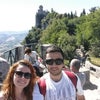The Church or Basilica of San Vitale— styled an "ecclesiastical basilica" in the Roman Catholic Church, though it is not of architectural basilica form— is the most famous monument of Ravenna, Italy and is one of the most important examples of Byzantine Art and architecture in western Europe. The building is one of eight Ravenna structures inscribed on the UNESCO World Heritage List.
The church was begun by Bishop Ecclesius in 527, when Ravenna was under the rule of the Ostrogoths, and completed by the 27th Bishop of Ravenna, Maximian in 548 during the Byzantine Exarchate of Ravenna. The architect of this church is unknown, but he was certainly among the best architects of his time.
The church has an octagonal plan. The building combines Roman elements (the dome, shape of doorways, stepped towers) with Byzantine (polygonal apse, capitals, narrow bricks, etc). However, the church is most famous for its wealth of Byzantine mosaics, the largest and best preserved outside of Constantinople itself. The church is of extreme importance in Byzantine art, as it is the only major church from the period of Emperor Justinian to survive virtually intact to the present day; furthermore, it is thought to reflect the design of the Byzantine Imperial Palace Audience Chamber, of which nothing at all survives.
According to legend, the church was erected on the site of the martyrdom of Saint Vitalis. However, there is some confusion as to whether this is the Saint Vitalis of Milan, or the Saint Vitale whose body was discovered together with that of Saint Agricola, by Saint Ambrose in Bologna in 393.
The construction of the church was sponsored by a Greek banker, Iulianus Argentarius, of whom very little is known, except that he also sponsored the construction of the Basilica of Sant' Apollinare in Classe at around the same time. The final cost amounted to 26,000 gold pieces. The true sponsor may have been the Byzantine Emperor, who used such church construction projects as propaganda and as a way of speeding the incorporation of new territory into the Empire.
The central section is surrounded by two superposed ambulatories. The upper one, the matrimoneum, was reserved for married women. A series of mosaics in the lunettes above the triforia, depict sacrifices from the Old Testament : the story of Abraham and Melchizedek, and the Sacrifice of Isaac; the story of Moses and the Burning Bush, Jeremiah and Isaiah, representatives of the twelve tribes of Israel, and the story of Abel and Cain. A pair of angels, holding a medallion with a cross, crowns each lunette. On the side walls the corners, next to the mullioned windows, have mosaics of the Four Evangelists, under their symbols (angel, lion, bull and eagle), and dressed in white. Especially the portrayal of the lion is remarkable in its feral ferocity.
The cross-ribbed vault in the presbytery is richly ornamented with mosaic festoons of leaves, fruit and flowers, converging on a crown encircling the Lamb of God. The crown is supported by four angels, and every surface is covered with a profusion of flowers, stars, birds and animals, including many peacocks. Above the arch, on both sides, two angels hold a disc and beside them a representation of the cities of Jerusalem and Bethlehem. They symbolize the human race (Jerusalem representing the Jews, and Bethlehem the Gentiles).
All these mosaics are executed in the Hellenistic-Roman tradition : lively and imaginative, with rich colours and a certain perspective, and with a vivid depiction of the landscape, plants and birds. They were finished when Ravenna was still under Gothic rule.
The apse is flanked by two chapels, the prothesis and the diaconicon, typical for Byzantine architecture.
Inside, the intrados of the great triumphal arch is decorated with fifteen mosaic medallions, depicting Jesus Christ, the twelve Apostles and Saint Gervasius and Saint Protasius, the sons of Saint Vitale.
The theophany was begun in 525 under bishop Ecclesius. It has a great gold fascia with twining flowers, birds, and horns of plenty. Jesus Christ appears, seated on a blue globe in the summit of the vault, robed in purple, with his right hand offering the martyr's crown to Saint Vitale. On the left, Bishop Ecclesius offers a model of the church.
At the foot of the apse side walls are two famous mosaic panels, executed in 548. On the left is a mosaic depicting the Emperor Justinian, clad in purple with a golden halo, standing next to court officials, Bishop Maximian, praetorian guards and deacons. The halo around his head gives him the same aspect as Christ in the dome of the apse. Justinian himself stands in the middle, with soldiers on his left and clergy on this right, emphasizing that Justinian is the leader of both church and state of his empire. He also holds a paten and is shown with a 3 day beard to show that too busy to shave since he is performing his duties as emperor. The gold background of the mosaic shows that Justinian and his entourage are inside the church and gives off an otherworldly,spiritual vibe. The figures are placed in a V shape; Justinian is placed in the front and in the middle to show his importance with Bishop Maximian on his left and lesser individuals being placed behind them. This placement can be seen through the overlapping feet of the individuals present in the mosaic.
On the right side is Empress Theodora solemn and formal, with golden halo, crown and jewels, and a train of court ladies. She is almost depicted as a goddess. As opposed to the V formation of the figures in the Justinian mosaic, the mosaic with Empress Theodora shows the figures moving from left to right into the church. Theodora is seen holding the wine. These panels are almost the only surviving examples of Byzantine secular mosaic art, and offer a glimpse into the glory, splendor and pomp of the Byzantine world.
The Church of San Vitale inspired the design of the church of the Saints Sergius and Bacchus in Constantinople, then was the model used by Charlemagne for his Palatine Chapel in Aachen in 805, and centuries later its dome was the inspiration for Filippo Brunelleschi in the design for the dome of the Duomo of Florence.
The Church of San Vitale featured in the first episode of Lord Kenneth Clark's television series "Civilisation".





